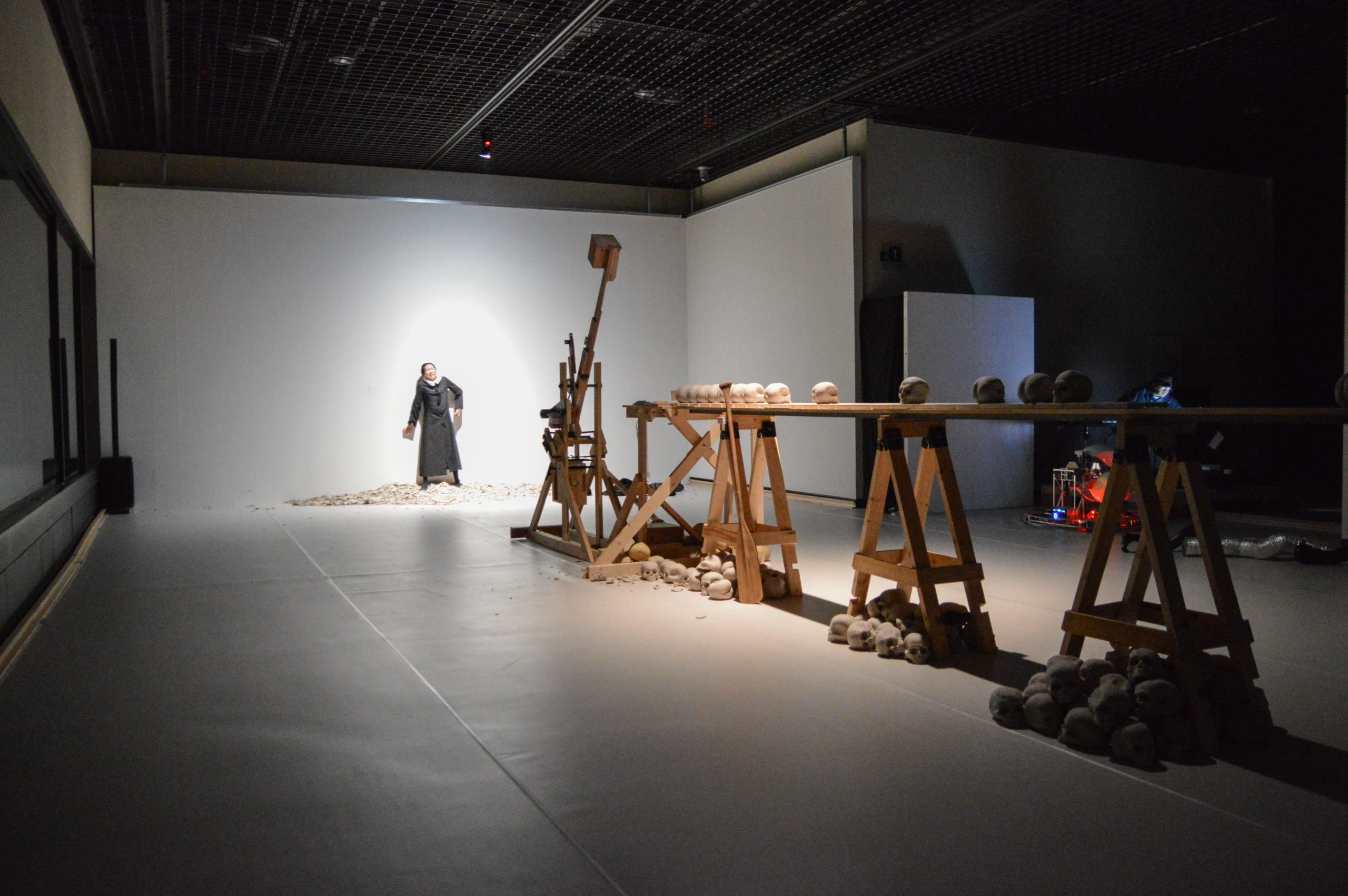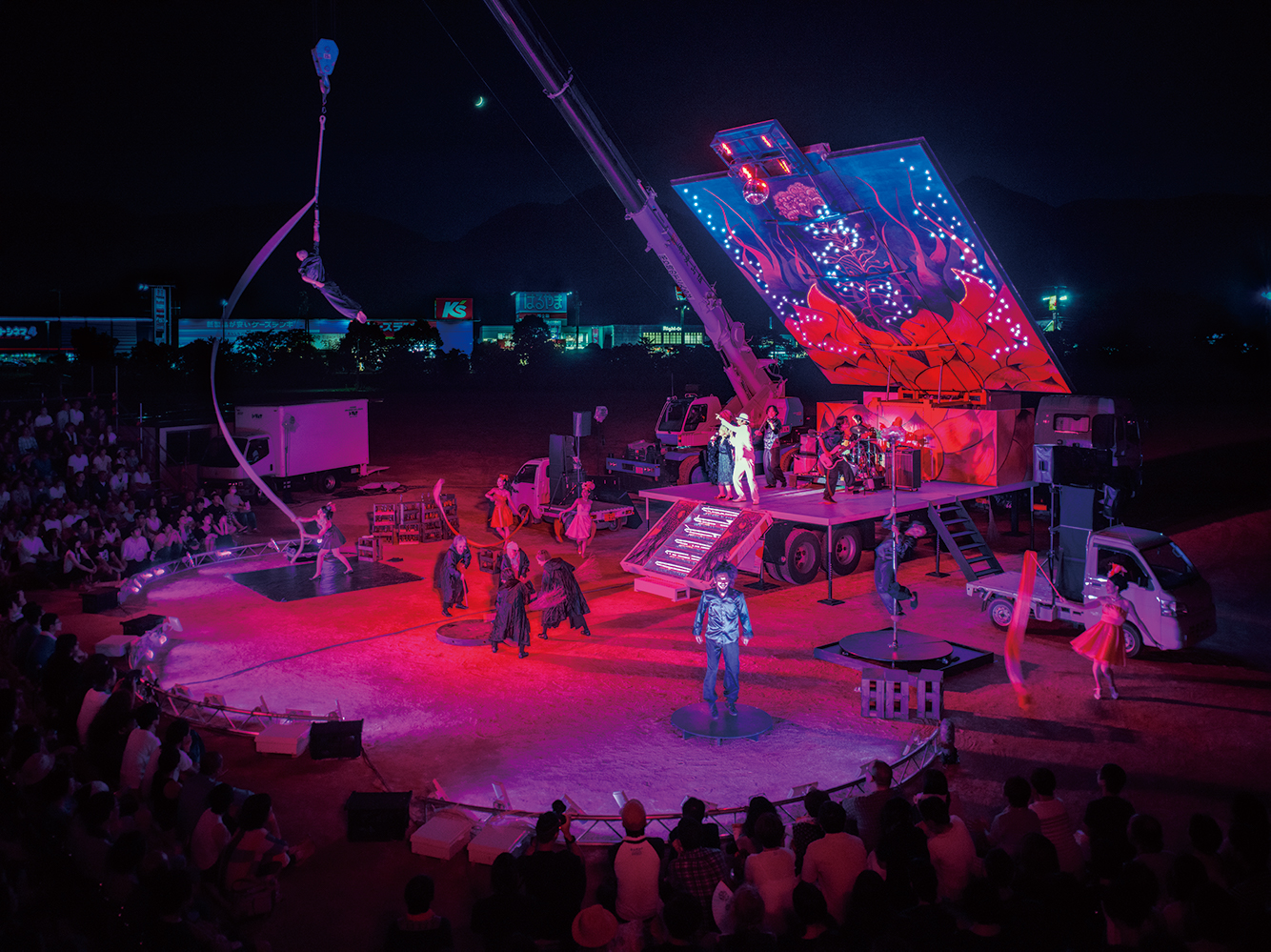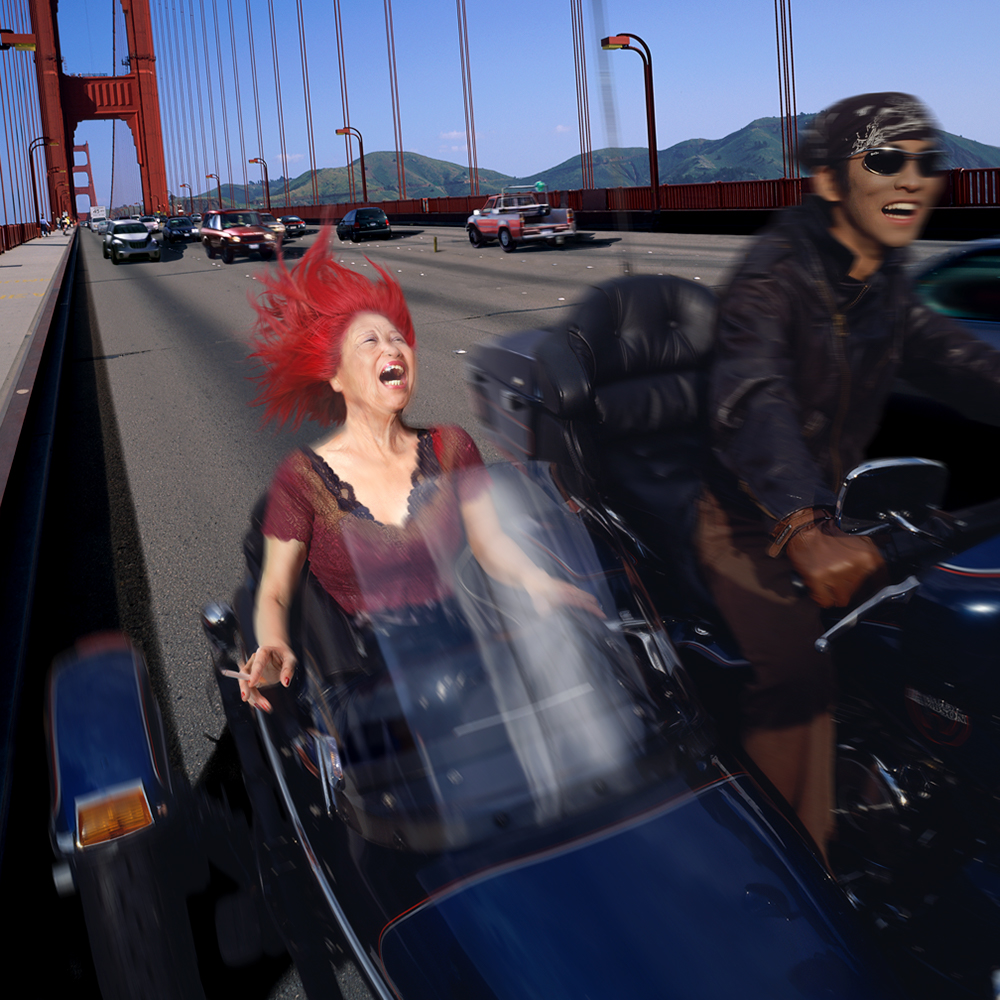やなぎみわ YANAGI Miwa

〈女神と男神が桃の木の下で別れる〉《 川中島Ⅱ 》2016年 デジタルプリント 160×285cm
The goddess and the god separate under the peach tree. Kawanakajima Ⅱ, 2016, Digital Print, 160×285cm
やなぎみわ
YANAGI Miwa
1967年、神戸市生まれ。京都市、神戸市に在住、活動。
2019年から1年をかけて、国内5つの美術館を巡回した「やなぎみわ展 神話機械」は、10年ぶりとなる大規模個展であり、「モバイル・シアター・プロジェクト」(動き回る小型劇場)として発表された新作《神話機械》は、デビュー以来、安住を知らないこの漂泊のアーティストの途方もない破壊と創造による結実であった。
やなぎは、美術と演劇、空間芸術と時間芸術、静止と流動、定着と漂流、視覚体験と身体体験、個人と集団作業といった両極を往還し作品を制作してきた。実際、『日輪の翼』(中上健次原作、2016年初演)で出自の異なる演者たちと旅の一座を組み、自然(天候・人間)に介入される振れ幅が大きい野外劇を敢行しながら、本展に向けては、真逆の、感情や主観を持たない4台のマシンの「型」による完全再演の舞台を目指した。ドイツの劇作家ハイナー・ミュラー(1929‐1995)の『ハムレットマシン』や『メディアマテリアル』などを引用したやなぎ構成・演出の《神話機械》は、マシンのみの無人公演であれ、トランスジェンダー俳優、高山のえみの鬼気迫る有人公演であれ、聖俗、男女、貴賤、老若、生死、清濁、天地といった対立構造を成すものが混沌へと戻る光景を展覧会場に立ち上がらせた。
また、野外劇制作の一方で、やなぎは東日本大震災後の福島に通い、夜の果樹園で撮影した桃を〈女神と男神が桃の木の下で別れる〉シリーズとして発表した。『古事記』にインスピレーションを得た本作は、《神話機械》と表裏一体ともいえる作品であり、火と桃投げと別離の古代神話はジェンダー論はじめ「自然と文明」の問題をも提起した。展覧会場では、たわわに実をつけた桃の木と投擲マシン「ムネーメー」により粉砕され積みあがった髑髏の残骸が呼応しあい、やなぎが暴力的に放った「新たな神話」に生と死が灯された。
野外劇『日輪の翼』と同胞はらからである本展は巡礼を終えたが、歌と物語を運び、また人外に悲喜劇を立ち上げようとするやなぎの行く手は見逃せない。
毛利直子(高松市美術館学芸員)
Born in Kobe, Japan 1967. Lives and Works in Kyoto and in Kobe, Japan.
The exhibition MIWA YANAGI: Myth Machines, which traveled to five art museums nationwide over the course of one year, beginning in February 2019, was the first large-scale exhibition that Yanagi had held in ten years. Her new work Myth Machines, which was shown as the Mobile Theater Project, was the fruition of the incredibly destructive and creative powers of this nomadic artist. She has never been content to be tied down to one specific genre ever since her debut in the art world.
Yanagi has produced works through going back and forth between sets of opposite poles—namely, art and theatrical performance; spatial and temporal art; stillness and fluidity; settling and drifting; visual and physical experience; and individual and group activity. In fact, for the outdoor traveling theatrical work The Wings of the Sun (based on the novel written by Nakagami Kenji in 1984; Yanagi’s first performance was in 2016), Yanagi organized a traveling troupe with performers from different fields. She ventured to hold it in open-air settings, which involved a great degree of instability due to the intervention of natural forces (such as weather and people). In exact opposition to this, for her current series of exhibitions, Myth Machines, she aimed to show a complete restaging of a fixed “model” performance. This series consists of four machines that have no emotions or subjectivity. For the live performance, staged and directed by Yanagi, she has adopted scenes from the German dramatist Heiner Müller’s (1929–1995) Hamlet Machine and Media Material. Inside the venue, she has manifested a sight in which opposing relationships—such as the sacred and the profane, man and woman, old and young, life and death, good and evil, and heaven and earth—have returned to their original state of chaos. This was shown in both the unmanned performance staged by the four machines and in the unearthly, manned performance in which those machines were joined by the transgender actor Takayama Noemi.
In addition, at the same time that she produced the forementioned open-air performance, Yanagi frequently visited Fukushima after the Great East Japan Earthquake had occurred. During her visits, she photographed peaches at a fruit orchard at night, which were exhibited as the series The Goddess and the God Separate Under the Peach Tree. This series, which derived from Yanagi being inspired by Kojiki (Records of Ancient Matters), can be seen as being inextricably linked with Myth Machines. For one of the ancient myths in Kojiki, involving fire, peach throwing and separation, raises questions concerning “nature and civilization,” including one centered around gender theory. Inside the exhibition venue, the peach tree laden with fruit in her photographic works and the debris from skulls that accumulated in one part of the venue, which were smashed by the throwing machine “Mneme,” interacted with each other, resulting in the giving of life and death to the “new myth” that she destructively launched.
Although this series of exhibitions, which was like a “sibling” to the outdoor traveling theatrical work The Wings of the Sun, has completed its tour, we must not miss out on the future activities of Yanagi Miwa, who endeavors to deliver songs and stories to us, while also attempting to establish a tragicomedy in the middle of nowhere.
MOHRI Naoko, Curator, Takamatsu Art Museum
(Translated by NANPEI Taeko)
更新された最新の情報は、作家のウェブサイトをご覧ください。
Please refer to the artist’s website for new updates.
AWARE: Archives of Women Artists, Research & Exhibitions
https://awarewomenartists.com/en/artiste/miwa-yanagi/
AWARE-日本

パフォーマンス《MM》 公演風景(《神話機械》のマシンと俳優が共演する有人公演)2019年 静岡県立美術館
構成・演出:やなぎみわ 出演:高山のえみ 音楽:内橋和久
MM, Collaborative performance by the machine from Myth Machines and the actor, 2019, Shizuoka Prefectural Museum of Art, Japan
Written and Directed by YANAGI Miwa, Performance by TAKAYAMA Noemi, Music by UCHIHASHI Kazuhisa

《アルゴー船の船首像 2》2019年 デジタルプリント 120×84cm
Figurehead for Argo 2, 2019, Digital Print, 120×84cm

野外劇《日輪の翼》 2016年~ 演出・美術:やなぎみわ 原作:中上健次 新宮公演風景 撮影:表恒匡
the Outdoor Play, The Wings of the Sun, 2016~, Directed by YANAGI Miwa, Written by NAKAGAMI Kenji, Venue: Shingu, Wakayama Photo by OMOTE Nobutada

演劇作品《ゼロ・アワー 東京ローズ最後のテープ》2013-2015年 作・演出・美術:やなぎみわ 京都芸術劇場 春秋座公演風景 撮影:木村三晴
the Play, ZERO HOUR:Tokyo Rose’s Last Tape, 2013-2015 Written and directed by YANAGI Miwa, Venue: Kyoto Art Theater Shunjuza, Photo by KIMURA Sansei

《My Grandmothers/YUKA》2000年 デジタルプリント 160×160cm
My Grandmothers/YUKA, 2000, Digital Print, 160×160cm

《案内嬢の部屋 1F》1997年 発色現像方式印画 240×200cm (2点)
Elevator Girl House 1F, 1997, Chromogenic print, 240×200cm (2 pieces)

